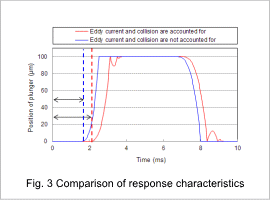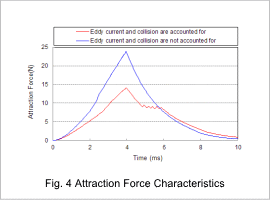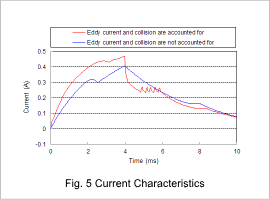Overview
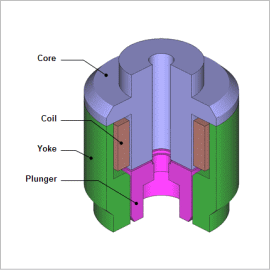
In solenoid injectors, one of the reasons that the response is delayed is eddy currents, which are produced when the magnetic flux generated by current flow undergoes time variations. The eddy currents are generated in a direction that inhibits changes in the magnetic flux, causing a delay in the initial rise of the attraction force when the current begins to flow. This reduces the injector’s responsiveness. Also, the reflection of the plunger at collision during open/close inhibits the open/close motion.
By running a transient response analysis in JMAG, the responsiveness of the injector accounting for the effect of the collision of the plunger and the eddy current can be obtained. Identifying the places where eddy currents are generated enables a designer to study whether or not responsiveness can be improved.
For this case, direct current voltage is applied to the solenoid type injector and the response characteristics is obtained after accounting for the effect of the collision and eddy current.
Position of Plunger and Coil Current
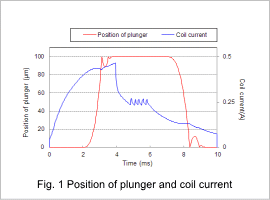
Current Density Distribution
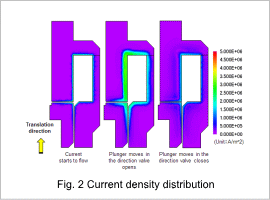
Comparison of Response Characteristics
Depending on whether you account for eddy current and collision, the comparison of response characteristics of the plunger for each time is shown in Fig. 4 The attraction force characteristics is shown in Fig. 4, and current characteristics is in Fig. 5. The position of the plunger is positive in the direction the valve opens and the valvle is full open at position 100(μm) and the valve is closed at position 0 (μm).
Fig. 3 shows that the plunger is bouncing near 3.2 (ms) due to the collision, when eddy current and collision are accounted for. Also, the responsiveness is slower compared to when they are not accounted for.
The slow responsiveness is caused by the reduced attraction force. In Fig. 4, the lower attraction force can be verified when eddy current and collision are considered compared to when they are not considered.
As for the current characteristics, when the eddy current and collision are considered, the larger current value can be seen compared to when they are not considered. For more information about the cause, see the Application Note “66 – Operating Time Analysis of an Injector “.
When the plunger moves in the direction to open the valve, there will be a delay in response of approximately 1.5(ms) due to the fuel pressure, spring and the weight of the plunger in the case that eddy current and collision are not accounted for. In the case when eddy current and collision are accounted for, the delay in response is approximately 2 (ms) and it can be confirmed that the cause of delay in response is the decrease of the attractive force due to eddy current. The plunger will move to the direction of closing the valve from 7 (ms). Also, the eddy current caused magnetic flux and result in a delay of the plunger displacement. In addition, the plunger will collide and reflect, and it can be confirmed that more time is required for the open/close of the valve.
